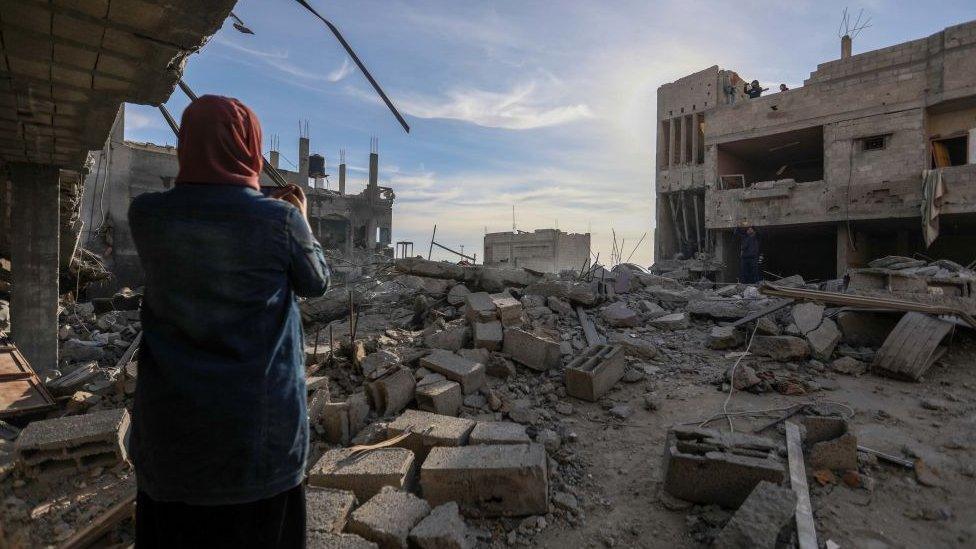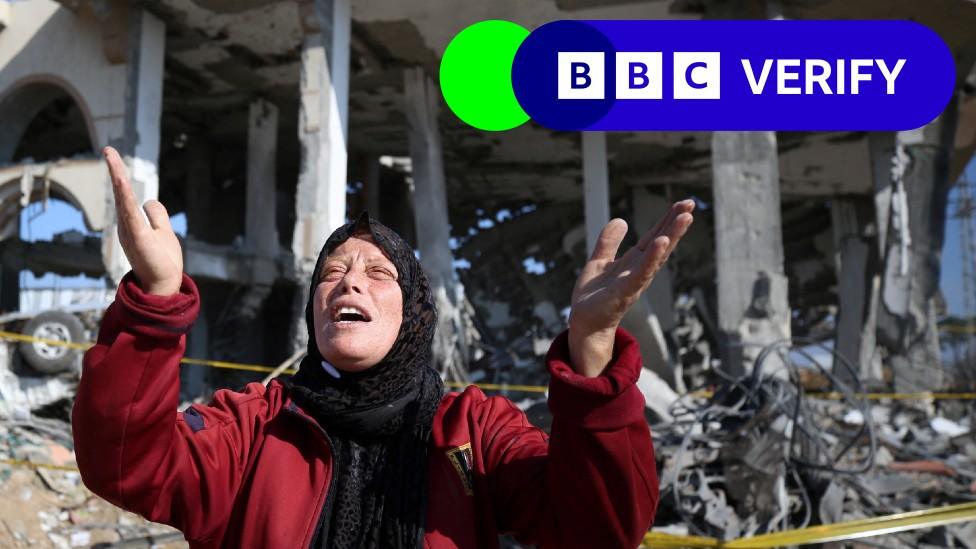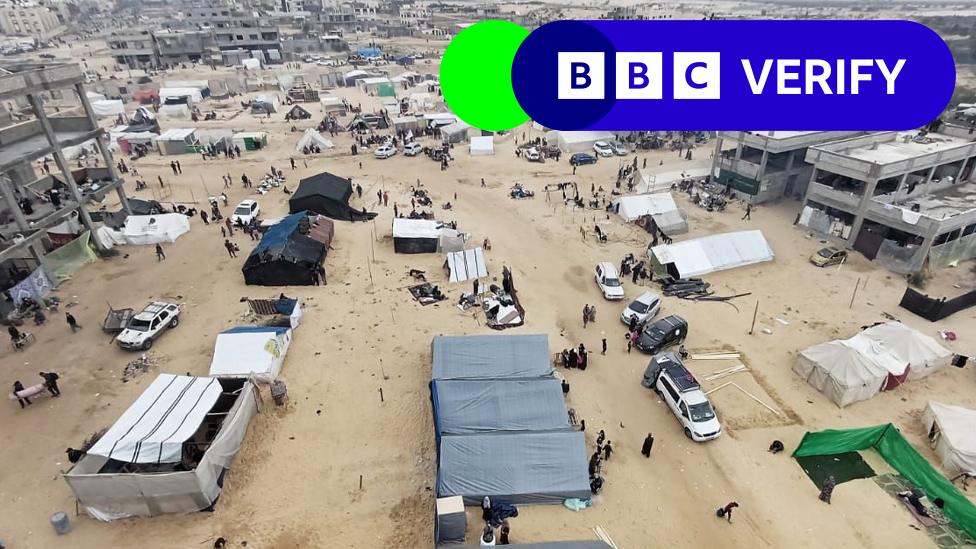Israel’s assault on Rafah looms, but no plan yet to evacuate civilians
- Published

Israel's military campaign in the Gaza Strip has worked its way inexorably south over the course of four months.
Inevitably, it's now arrived at Rafah, the Strip's southernmost city.
But with that inevitability comes the equally predictable dilemma of what to do with as many as 1.5 million civilians sheltering in an area that had a pre-war population of around 270,000.
Satellite images of Rafah show that virtually every open space in the city has been taken up by tents and other temporary shelters.
By some estimates, the population density has soared from 4,100 people per square kilometre to something approaching 20,000.
Your device may not support this visualisation
The city is now one vast refugee camp, populated by people who have fled from cities, refugee camps and villages further north.
Many, perhaps most, have had to move several times. They have lost homes, possessions and family members.
They are exhausted, traumatised, hungry and sick.
And now, it seems, they're being told to leave once more.
Which begs the question: where can they go?
Israel's prime minister, Benjamin Netanyahu, said last week that he had ordered his military to draw up an evacuation plan, ahead of the assault on Rafah.
But details of that plan are sketchy. It's not even clear if a plan yet exists.
"This is still being developed," Israel Defense Forces spokesman Lt Col Richard Hecht said today.
On Friday, government spokesman Eylon Levy said Israel was "talking about supporting an evacuation to open areas inside the Gaza Strip where it will be possible to set up tent encampments."
Interviewed by ABC news over the weekend, Mr Netanyahu was equally vague.
"The areas that we've cleared north of Rafah, plenty of areas there," he said, without giving further details.
What the prime minister didn't say, but which is painfully apparent, is that in order to move 1.5 million people out of harm's way, Israel needs the cooperation of the international aid community, in particular the UN Relief and Works Agency (UNRWA) the UN agency responsible for Palestinian refugees.
On Monday, Mr Levy made what he called "an urgent appeal" to the international community.
"We urge UN agencies to cooperate with Israel's efforts to protect civilians from Hamas," he said, "and evacuate them from a war zone where terrorists are trying to use them as human shields. Don't say it can't be done."
But in recent weeks, Israel has declared war on UNRWA, accusing staff members of complicity in the October 7th attacks and saying the agency turned a blind eye to the presence of Hamas in its midst - or in some cases under its feet.
In recent days, Israeli officials have stepped up their calls for UNRWA's commissioner general, Philippe Lazzarini, to resign.
After more than 70 years of looking after Palestinian refugees across the Middle East, Israel says it's time for the agency to be disbanded.
As he appealed for help from the international community this morning, Eylon Levy launched another furious assault on the UN, accusing it of "funnelling civilians into Hamas strongholds and…validating the Hamas human shields strategy."
With relations with the UN at rock bottom, the prospects for cooperation over the evacuation of 1.5 million people are vanishingly small.
"We have no plans to move anyone anywhere," UNRWA's spokesperson Juliette Touma told me.
Speaking from Rafah, Hisham Mhanna of the International Committee of the Red Cross said it was hard to see how an evacuation on such a vast scale could be conducted.
"I cannot imagine that any international organisation would have the capacity, the logistical preparations and the security guarantees to evacuate hundreds of thousands of people," he told BBC Radio's The World At One.
"Plus there is no destination to evacuate this large number of people. There's nowhere in Gaza now that is equipped as a safe environment."
In the early weeks of the conflict, Israeli officials urged Palestinians to seek shelter in al-Mawasi, a sandy, agricultural area next to the Mediterranean Sea, not far from Rafah.
By early January, an estimated 300,000 people had fled to al-Mawasi.
Despite promises of aid, those arriving there found no potable water or bathrooms. Most had to set up their own tents.

An estimated 300,000 people had fled to al-Mawasi by early January
With the EU's foreign policy chief, Josep Borrell, warning that an Israeli military assault on Rafah would lead to "an unspeakable humanitarian catastrophe" and UNRWA's Philippe Lazzarini saying it "would add an additional apocalyptic layer" to Gaza's desperate plight, the clock appears to be ticking.
Speaking to journalists on Monday afternoon, Lt Col Richard Hecht noted the start, in less than a month's time, of Ramadan - one of the most holy months in the Islamic calendar.
He wouldn't be drawn on whether he wanted to see a civilian evacuation completed by then, saying only that it was something in the calendar that "could influence the landscape of events."
Given the apparent vagueness of plans to conduct a civilian evacuation on an unprecedented scale, it's hard to see how a land assault on Rafah can begin any time soon.
How long it then lasts is anyone's guess.
Israel says that of Hamas' six remaining battalions, four are in Rafah. It's possible that some of the group's main leaders are also there - although the existence of tunnels from Rafah into Egypt also means that some may have escaped the Gaza Strip.
Israeli troops are still fighting in nearby Khan Yunis, where a land assault began two and a half months ago.
The assault on Rafah, which began with air strikes soon after the Hamas attacks of October 7th, looks set to continue for some time.
Unless a ceasefire brings some respite.
Related topics
- Published31 January 2024

- Published30 January 2024

- Published8 December 2023

- Published3 February 2024
